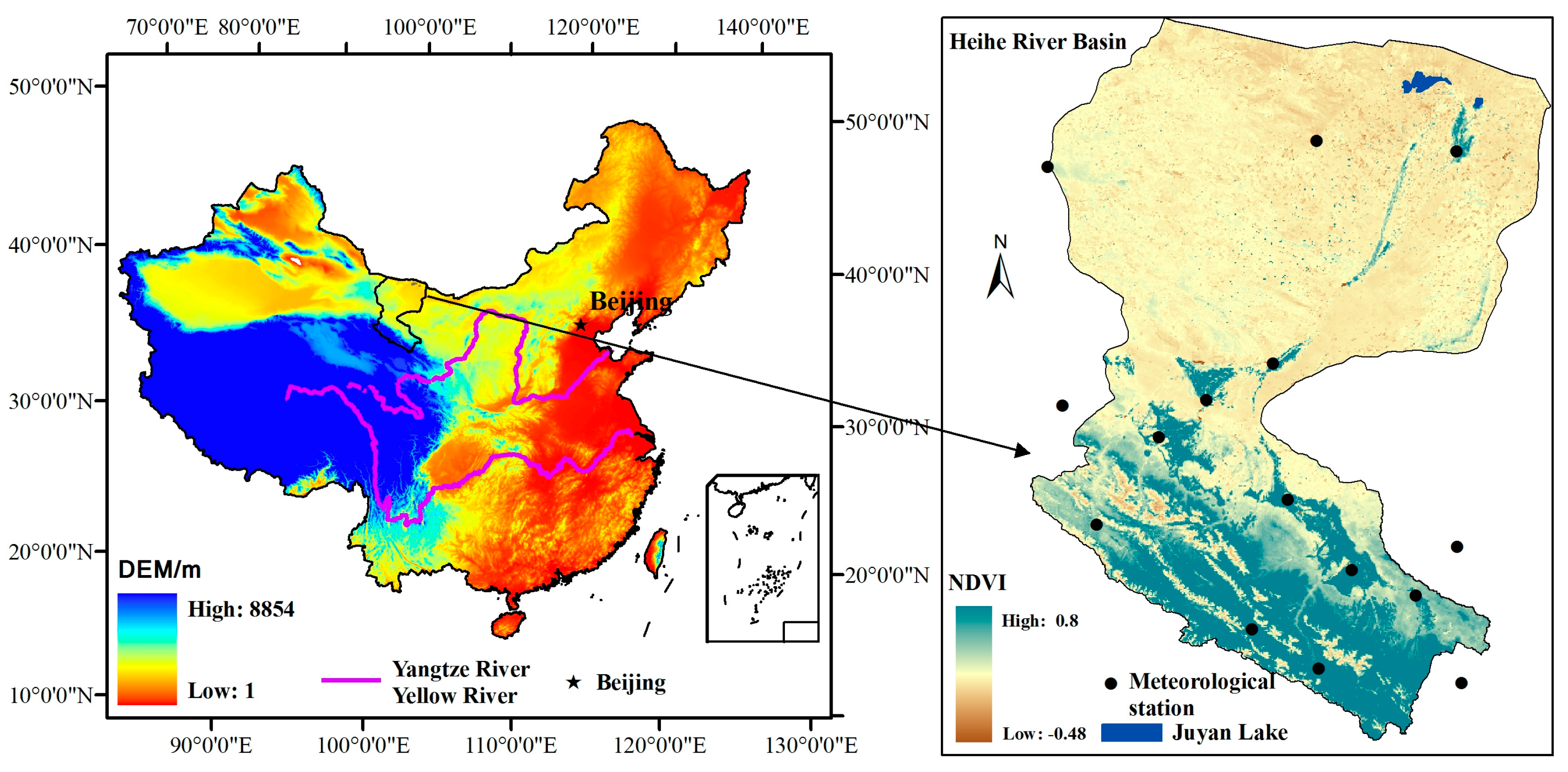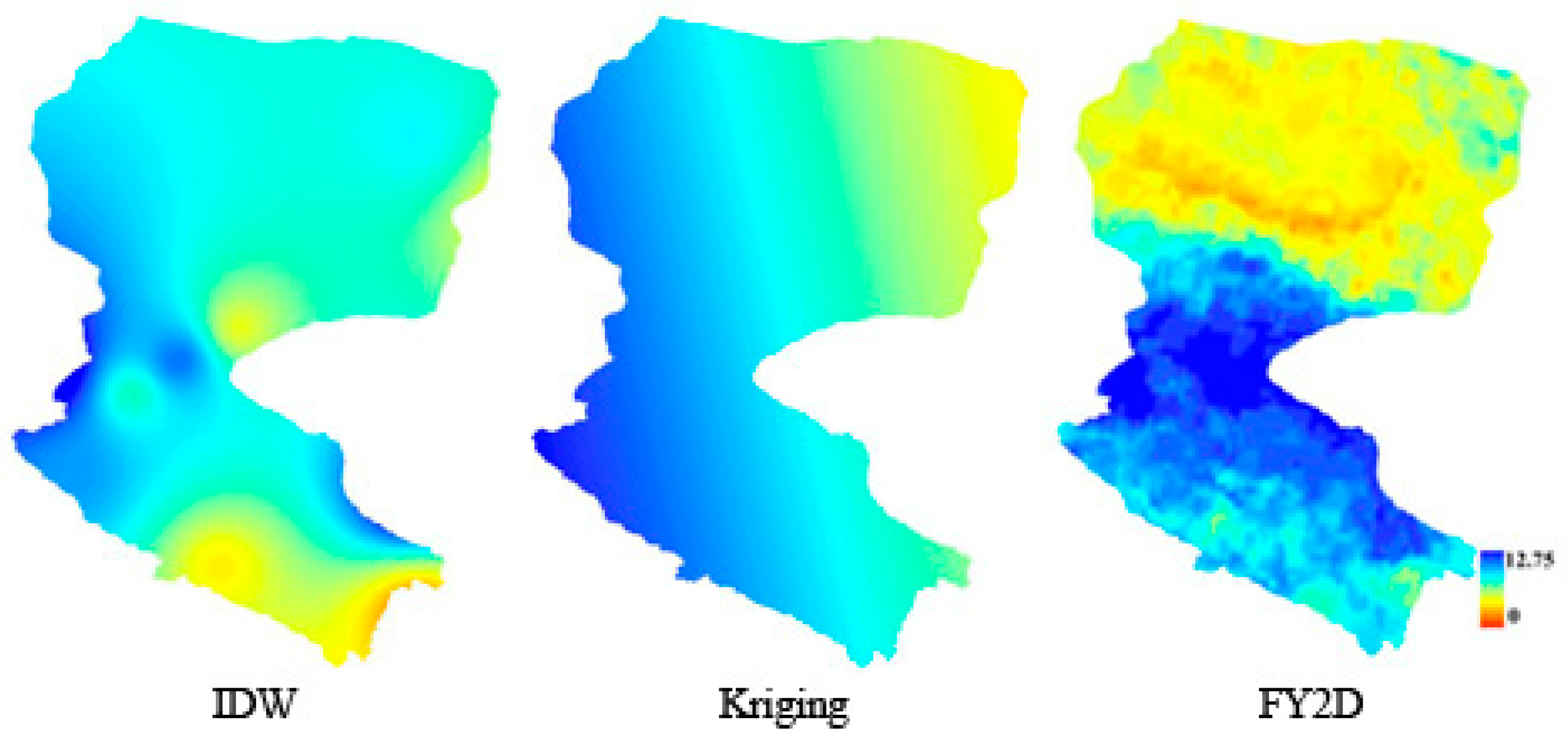A Method to Estimate Sunshine Duration Using Cloud Classification Data from a Geostationary Meteorological Satellite (FY-2D) over the Heihe River Basin
Abstract
:1. Introduction
2. Materials and Methods
2.1. Study Site and Datasets
2.2. Methodology
2.2.1. Data and Pre-Processing Methods
Sunshine Duration Observation Data
Geostationary Meteorological Cloud Products Data
2.2.2. Modelling Sunshine Duration
FY-2D Cloud Type Sunshine Factor
FY-2D Cloud Type Sunshine Factor Estimation
2.2.3. Model Performance Assessment
3. Results
4. Discussion
5. Conclusions
Acknowledgments
Author Contributions
Conflicts of Interest
References
- Angstrom, A. Solar and terrestrial radiation. Q. J. R. Meteorol. Soc. 1924, 50, 121–125. [Google Scholar] [CrossRef]
- Xue, L.F. Agricultural climatic regionalization for Longyan cultivation in Guangdong province. J. Trop. Meteorol. 2011, 27, 403–409. [Google Scholar]
- Huang, Y.L.; Xiu, S.Y.; Zhong, S.Q.; Zheng, L.; Sun, H. Division of banana for climatic suitability based on a decision tree. J. Trop. Meteorol. 2012, 28, 140–144. [Google Scholar]
- Wang, B.Z. Solar energy resources in China. Eng. Thermophys. 1980, 1, 1–9. [Google Scholar]
- Zhu, C.H. A further discussion on the method of calculating total radiation in climatological study (I). J. Nanjing Inst. Meteorol. 1982, 5, 15–24. [Google Scholar]
- Zhu, C.H. A further discussion on the climatological calculating method of total radiation (II). J. Nanjing Inst. Meteorol. 1982, 5, 196–206. [Google Scholar]
- Robaa, S. Evaluation of sunshine duration from cloud data in Egypt. Energy 2008, 33, 785–795. [Google Scholar] [CrossRef]
- Qian, H. Study on the Measurement Method of Direct Radiation Sunshine Hour. Master’s Thesis, Nanjing University of Information Science and Technology, Nanjing, China, 2013. [Google Scholar]
- Matuszko, D. A comparison of sunshine duration records from the Campbell-stokes sunshine recorder and CSD3 sunshine duration sensor. Theor. Appl. Climatol. 2015, 119, 401–406. [Google Scholar] [CrossRef]
- Zuo, D.K. Studies on Radiation in the Epigedsphere; Science Press: Beijing, China, 1991. [Google Scholar]
- Zeng, Y. The spatial distribution of sunshine hours under undulating terrain of China. Prog. Nat. Sci. 2003, 13, 545–548. [Google Scholar]
- Wang, H.Q. Refine project model of sunshine resources in China considering terrain masking. J. Agrometeorol. 2011, 32, 273–278. (In Chinese) [Google Scholar]
- Barbaro, S.; Coppolino, S.; Leone, C.; Sinagra, E. Global solar radiation in Italy. Sol. Energy 1978, 20, 431–435. [Google Scholar] [CrossRef]
- Ibrahim, S.M.A. Predicted and measured global solar radiation in Egypt. Sol. Energy 1985, 35, 185–188. [Google Scholar] [CrossRef]
- Canada, J. Solar radiation prediction from sunshine in eastern Spain. Renew. Energy 1992, 3, 219–221. [Google Scholar]
- Halouani, N.; Nguyen, C.T.; Vo-Ngoc, D. Calculation of monthly average global solar radiation on horizontal surfaces using daily hours of bright sunshine. Sol. Energy 1993, 50, 247–258. [Google Scholar] [CrossRef]
- Gueymard, C. Analysis of monthly average solar radiation and bright sunshine for different thresholds at Cape Canaveral, Florida. Sol. Energy 1993, 51, 139–145. [Google Scholar] [CrossRef]
- Revfeim, K. On the relationship between radiation and mean dailysunshine. Agric. For. Meteorol. 1997, 86, 183–191. [Google Scholar] [CrossRef]
- Muneer, T.; Gul, M.S. Evaluation of sunshine and cloud cover based models for generating solar radiation data. Energy Convers. Manag. 2000, 41, 461–482. [Google Scholar] [CrossRef]
- Akpabio, L.K.; Etuk, S.E. Relationship between global solar radiation and sunshine duration for Onne, Nigeria. Turk. J. Phys. 2003, 27, 161–167. [Google Scholar]
- Vivar, M.; Fuentes, M.; Norton, M.; Makrides, G.; de Bustamante, I. Estimation of sunshine duration from the global irradiance measured by a photovoltaic silicon solar cell. Renew. Sustain. Energy Rev. 2014, 36, 26–33. [Google Scholar] [CrossRef]
- Wang, Y.; Yang, Y.; Zhao, N.; Liu, C.; Wang, Q. The magnitude of the effect of air pollution on sunshine hours in China. J. Geophys. Res. 2012, 117. [Google Scholar] [CrossRef]
- Brabec, M.; Badescu, V.; Dumitrescu, A.; Paulescu, M. A new point of view on the relationship between global solar irradiation and sunshine quantifiers. Sol. Energy 2016, 126, 252–263. [Google Scholar] [CrossRef]
- Good, E. Estimating daily sunshine duration over the UK from geostationary satellite data. Weather 2010, 65, 324–328. [Google Scholar] [CrossRef]
- Kothe, S.; Good, E.; Obregón, A.; Ahrens, B.; Nitsche, H. Satellite-based sunshine duration for Europe. Remote Sens. 2013, 5, 2943–2972. [Google Scholar] [CrossRef]
- Journée, M.; Demain, C.; Bertrand, C. Sunshine duration climate maps of Belgium and Luxembourg based on Meteosat and in-situ observations. Adv. Sci. Res. 2013, 10, 15–19. [Google Scholar] [CrossRef]
- He, P. Practical Manual for Satellite Service Products and Satellite Data Formats for Chinese Geostationary Meteorological; China Meteorological Press: Beijing, China, 2008. [Google Scholar]
- Song, X.Y.; Shu, Q.; Wang, H.; Liao, W. Comparison and application of SCE-UA, genetic algorithm and simplex method. Eng. J. Wuhan Univ. 2009, 42, 6–25. [Google Scholar]
- Cai, J.; Liu, Y.; Lei, T.; Pereira, L.S. Estimating reference evapotranspiration with the FAO Penman–Monteith equation using daily weather forecast messages. Agric. For. Meteorol. 2007, 145, 22–35. [Google Scholar] [CrossRef]
- Colaizzi, P.D.; Evett, S.R.; Howell, T.A.; Tolk, J.A. Comparison of five models to scale daily evapotranspiration from one-time-of-day measurements. Trans. ASAE 2006, 49, 1409–1417. [Google Scholar] [CrossRef]
- Liu, G.; Hafeez, M.; Liu, Y.; Xu, D.; Vote, C. A novel method to convert daytime evapotranspiration into daily evapotranspiration based on variable canopy resistance. J. Hydrol. 2012, 414–415, 278–283. [Google Scholar] [CrossRef]



| Station | Longitude E (°) | Latitude N (°) | Elevation (m) | |
|---|---|---|---|---|
| No. | Name | |||
| 52267 | Ejin Banner | 101.09 | 41.94 | 940.50 |
| 52323 | Mazongshan | 97.11 | 41.51 | 1770.40 |
| 52436 | Yumenzhen | 97.55 | 39.84 | 1526.00 |
| 52446 | Dingxin | 99.51 | 40.31 | 1177.40 |
| 52447 | Jinta | 98.91 | 40.00 | 1270.50 |
| 52533 | Jiuquan | 98.50 | 39.70 | 1477.20 |
| 52546 | Gaotai | 99.79 | 39.36 | 1332.20 |
| 52576 | Alxa Right Banner | 101.43 | 39.14 | 1510.10 |
| 52633 | Tuole | 98.01 | 39.03 | 3367.00 |
| 52645 | Yeniugou | 99.58 | 38.42 | 3320.00 |
| 52652 | Zhangye | 100.46 | 38.91 | 1482.70 |
| 52657 | Qilian | 100.24 | 38.19 | 2787.40 |
| 52661 | Shandan | 101.08 | 38.77 | 1764.60 |
| 52674 | Yongchang | 101.58 | 38.18 | 1976.90 |
| Number | Code | Cloud Type | Abbreviation |
|---|---|---|---|
| 1 | 0/1 | Clear Sky | CLS |
| 2 | 11 | Mixed pixels | MIP |
| 3 | 12 | Altostratus or nimbostratus | ALN |
| 4 | 13 | Cirrostratus | CIS |
| 5 | 14 | Cirrus spissatus | CIRS |
| 6 | 15 | Cumulonimbus | CUC |
| 7 | 21 | Stratocumulus or altocumulus | STA |
| Station Name | CLS | MIP | ALN | CIS | CIRS | CUC | STA |
|---|---|---|---|---|---|---|---|
| Ejin Banner | 0.86–0.93 | 0.18–0.25 | 0.22–0.28 | 0.44–0.56 | 0.18–0.26 | 0.10–0.15 | 0.30–0.39 |
| Mazongshan | 0.80–0.90 | 0.16–0.29 | 0.20–0.27 | 0.47–0.54 | 0.19–0.26 | 0.12–0.14 | 0.32–0.36 |
| Yumenzhen | 0.83–0.96 | 0.18–0.27 | 0.24–0.29 | 0.48–0.55 | 0.17–0.27 | 0.09–0.14 | 0.30–0.41 |
| Dingxin | 0.79–0.98 | 0.18–0.26 | 0.21–0.28 | 0.50–0.54 | 0.22–0.27 | 0.08–0.15 | 0.32–0.38 |
| Jinta | 0.81–0.94 | 0.20–0.24 | 0.25–0.26 | 0.46–0.57 | 0.18–0.27 | 0.10–0.15 | 0.33–0.37 |
| Jiuquan | 0.80–0.94 | 0.17–0.28 | 0.22–0.27 | 0.46–0.55 | 0.23–0.25 | 0.09–0.16 | 0.31–0.36 |
| Gaotai | 0.85–0.95 | 0.18–0.27 | 0.20–0.29 | 0.49–0.53 | 0.22–0.28 | 0.10–0.14 | 0.30–0.37 |
| Alxa Right Banner | 0.82–0.93 | 0.18–0.27 | 0.23–0.26 | 0.48–0.58 | 0.18–0.27 | 0.11–0.15 | 0.32–0.36 |
| Tuole | 0.80–0.96 | 0.20–0.25 | 0.21–0.26 | 0.45–0.55 | 0.23–0.26 | 0.10–0.15 | 0.34–0.37 |
| Yeniugou | 0.80–0.93 | 0.18–0.27 | 0.23–0.28 | 0.47–0.56 | 0.19–0.25 | 0.12–0.14 | 0.30–0.38 |
| Zhangye | 0.87–0.92 | 0.15–0.22 | 0.22–0.32 | 0.48–0.58 | 0.21–0.25 | 0.09–0.15 | 0.33–0.36 |
| Qilian | 0.78–0.92 | 0.20–0.25 | 0.19–0.29 | 0.49–0.52 | 0.18–0.27 | 0.11–0.14 | 0.31–0.38 |
| Shandan | 0.83–0.96 | 0.18–0.28 | 0.22–0.28 | 0.47–0.53 | 0.22–0.25 | 0.10–0.16 | 0.32–0.37 |
| Yongchang | 0.81–0.95 | 0.18–0.27 | 0.20–0.30 | 0.48–0.53 | 0.20–0.25 | 0.12–0.15 | 0.34–0.36 |
| Range | 0.78–0.98 | 0.15–0.29 | 0.19–0.32 | 0.45–0.58 | 0.17–0.28 | 0.08–0.16 | 0.30–0.41 |
| Code | Surface Cloud Coverage Type (Cloud Classification) | Sunshine Factor |
|---|---|---|
| 0/1 | Clear sky | 0.9 |
| 11 | Mixed pixels | 0.21 |
| 12 | Altostratus or nimbostratus | 0.25 |
| 13 | Cirrostratus | 0.51 |
| 14 | Cirrus spissatus | 0.24 |
| 15 | Cumulonimbus cloud | 0.13 |
| 21 | Stratocumulus or altocumulus | 0.35 |
| Station Name | Observed Average | Estimated Average | R2 | MAE | RMSE | d |
|---|---|---|---|---|---|---|
| Ejin Banner | 9.175 | 8.949 | 0.916 | 0.784 | 1.105 | 0.997 |
| Mazongshan | 9.668 | 9.241 | 0.913 | 0.914 | 1.220 | 0.996 |
| Yumenzhen | 8.899 | 8.720 | 0.909 | 1.048 | 1.418 | 0.994 |
| Dingxin | 9.148 | 9.010 | 0.925 | 0.951 | 1.269 | 0.996 |
| Jinta | 9.293 | 9.013 | 0.910 | 1.035 | 1.332 | 0.995 |
| Jiuquan | 8.554 | 8.330 | 0.914 | 1.105 | 1.425 | 0.994 |
| Gaotai | 8.317 | 8.231 | 0.919 | 1.137 | 1.462 | 0.993 |
| Alxa Right Banner | 9.395 | 8.662 | 0.892 | 1.184 | 1.558 | 0.993 |
| Tuole | 8.352 | 7.697 | 0.860 | 1.296 | 1.626 | 0.991 |
| Yeniugou | 7.470 | 7.200 | 0.850 | 1.235 | 1.551 | 0.990 |
| Zhangye | 8.280 | 7.999 | 0.925 | 1.099 | 1.397 | 0.990 |
| Qilian | 7.481 | 7.481 | 0.864 | 1.307 | 1.613 | 0.990 |
| Shandan | 8.045 | 7.838 | 0.904 | 1.136 | 1.463 | 0.993 |
| Yongchang | 8.264 | 7.866 | 0.911 | 1.084 | 1.379 | 0.994 |
© 2016 by the authors; licensee MDPI, Basel, Switzerland. This article is an open access article distributed under the terms and conditions of the Creative Commons Attribution (CC-BY) license (http://creativecommons.org/licenses/by/4.0/).
Share and Cite
Wu, B.; Liu, S.; Zhu, W.; Yu, M.; Yan, N.; Xing, Q. A Method to Estimate Sunshine Duration Using Cloud Classification Data from a Geostationary Meteorological Satellite (FY-2D) over the Heihe River Basin. Sensors 2016, 16, 1859. https://doi.org/10.3390/s16111859
Wu B, Liu S, Zhu W, Yu M, Yan N, Xing Q. A Method to Estimate Sunshine Duration Using Cloud Classification Data from a Geostationary Meteorological Satellite (FY-2D) over the Heihe River Basin. Sensors. 2016; 16(11):1859. https://doi.org/10.3390/s16111859
Chicago/Turabian StyleWu, Bingfang, Shufu Liu, Weiwei Zhu, Mingzhao Yu, Nana Yan, and Qiang Xing. 2016. "A Method to Estimate Sunshine Duration Using Cloud Classification Data from a Geostationary Meteorological Satellite (FY-2D) over the Heihe River Basin" Sensors 16, no. 11: 1859. https://doi.org/10.3390/s16111859
APA StyleWu, B., Liu, S., Zhu, W., Yu, M., Yan, N., & Xing, Q. (2016). A Method to Estimate Sunshine Duration Using Cloud Classification Data from a Geostationary Meteorological Satellite (FY-2D) over the Heihe River Basin. Sensors, 16(11), 1859. https://doi.org/10.3390/s16111859








